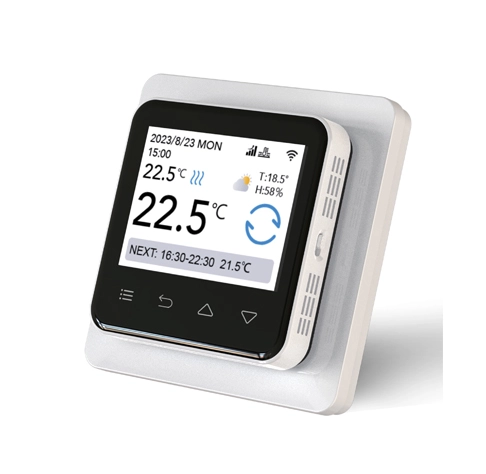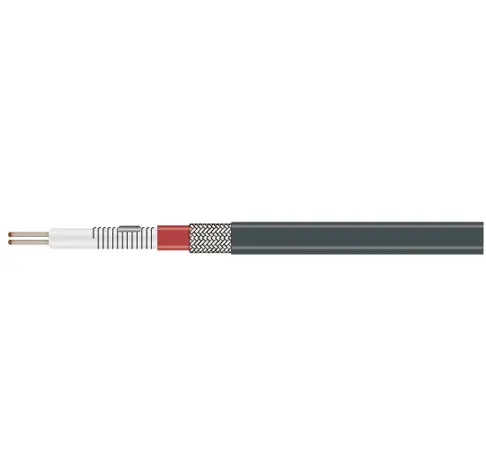Heat tracing technology is widely used in the industrial field, and its core lies in providing heat to pipelines, equipment, or systems through electric heating elements to ensure that the temperature is maintained within the process requirements or antifreeze requirements.
1. Oil and gas industry
Anti freezing measures for crude oil transportation: In cold regions such as Siberian oil fields, electric heat tracing prevents high viscosity crude oil from solidifying in pipelines and maintains fluidity.
Protection of natural gas processing equipment: Heating valves, instruments, and separators to prevent equipment failure caused by freezing of liquid hydrocarbons or hydrates.
Offshore platform application: In deep-sea oil and gas extraction, electric tracing ensures temperature stability of the wellhead control panel and subsea pipelines.
2. Chemical industry
Reaction kettle temperature control: In polymerization reactions, electric tracing maintains the kettle wall temperature to avoid medium crystallization (such as in polypropylene production).
Tank insulation: Heating tanks storing high-temperature media such as asphalt and sulfur to prevent solidification.
Pipeline blockage prevention: In pipelines transporting high melting point chemicals (such as phenol), prevent the medium from cooling and solidifying.
3. Power industry
Nuclear power plant safety system: Electrical tracing of emergency sprinkler system pipelines inside the containment vessel to ensure availability under accident conditions.
Environmental protection equipment for thermal power plants: In the desulfurization system (FGD), prevent the blockage of limestone slurry pipelines due to low-temperature crystallization.
Transformer oil temperature control: By using electric tracing to regulate the temperature of the cooling system, the efficiency of the transformer is optimized.
4. Architecture and Infrastructure
Fire protection system anti freezing: In extremely cold regions (such as Northern Europe), electric heating should be applied to the fire sprinkler pipes to avoid failure in winter.
Airport runway de icing: Embedded electric heat tracing system melts runway snow and reduces flight delays.
High rise building drainage: prevent roof drainage pipes from freezing and breaking, causing water damage.
5. Water treatment and environmental protection field
Wastewater treatment plant: Maintain the water temperature in the aeration tank to ensure microbial activity for wastewater treatment.
Desalination equipment: Heat the inlet pipeline of the reverse osmosis membrane to prevent a decrease in membrane performance at low temperatures.
Water source protection: Electric tracing of the water intake pipeline to prevent water supply interruption caused by winter icing.
6. Food and Drug Industry
Food and Beverage: Ensure that products such as chocolate or sauces remain fluid during processing and transportation.
Drug: Ensure temperature stability during drug synthesis and storage.
7.Technological advantages and scene adaptation
Accurate temperature control:
Self regulating electric heat tracing (such as Raychem self limiting cable) can automatically adjust the output power and is suitable for long-distance pipelines (such as oil and gas field gathering and transmission pipelines), saving energy and avoiding overheating.
The constant power system is suitable for complex piping systems (such as chemical plant heat exchangers), achieving ± 1 ℃ accuracy through distributed control.
Safety and reliability:
In explosion-proof areas (such as oil refineries), ATEX certified explosion-proof electric heat tracing systems are used, which comply with the IEC 60079-31 standard.
Double insulation and grounding protection design to reduce the risk of electrical fires.
Environmental adaptability:
In corrosive environments (such as chemical plants), use fluoropolymer insulated cables that are resistant to chemical media corrosion.
At extreme low temperatures (such as -60 ℃), low-temperature special cables are used to maintain heating efficiency.
Summarize
Electric heat tracing technology has become a key solution for industrial temperature management through its flexibility and reliability, covering a wide range of scenarios from energy extraction to municipal facilities. With the integration of intelligence and green energy technology, its application scenarios will further expand, helping to promote sustainable development in the industrial sector.


 EN
EN
 ja
ja  ko
ko  fr
fr  de
de  es
es  it
it  ru
ru  pt
pt  ar
ar  vi
vi 




